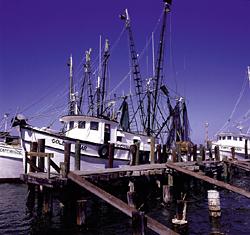
|
|
Photo courtesy of the
Florida Division of Historical Resources.
|
Florida’s northernmost seaport is located on the inland side of Amelia Island, three miles from the ocean via Cumberland Sound on the Florida/Georgia border. Fernandina was first settled in the mid-16th century by Spanish troops guarding the north Florida frontier. Its deep, natural harbor was suitable for defense and trade, primarily in cotton and indigo. In the early 19th century, Fernandina became a smuggling center for embargoed goods and illegal slave importation. Legitimate and illegitimate traders took advantage of these activities and Fernandina developed an international reputation both as an important commercial port and as a safe haven for pirates. Following an 1818 yellow fever epidemic, town and port languished until Fernandina became the eastern terminus of a cross-state rail line in 1853 with heavy trade was in cotton, timber, and naval stores. Union troops occupied Fernandina during the Civil War and, although most of the port's facilities were damaged or destroyed, a post-war boom occurred. Prior to the Spanish-American War, Cuban revolutionaries found shipping out of Fernandina easy and convenient. By the early 20th century, Fernandina's port activity revolved around shrimping, fishing, timber, and phosphate exports. Today, tourism and sport fishing also are important.
|






